
By Clara Sereni
Translated from Italian by Giulia Po and Monica Hanna
The velvet suit fits her well. Out of place, if it wasn’t for the jacket with the frogs and the Chinese-style collar: the only possible concession to her usual style, but not out of sync with what is expected from the mother of the bride. The purse with the embroidery and the silver handle is Aunt Clotilde’s, some of its threads torn by a century of history, and so much the worse for those who wouldn’t understand the preciousness of memory. The expensive shoes that Diletta inspected carefully don’t look like her.
She couldn’t choose: she couldn’t, otherwise the conflict with her daughter would have been irremediable.
She applies her makeup with more care than usual, but not differently: almost invisible powder, some blush on her cheeks, eyeliner around the eyes; no chance of tears, since for her uneasiness seems more likely than emotion at this wedding.
Long gone are the days of their complicity and friendship, when Diletta used to call her by name and not just mom, when they played and sang nursery rhymes and poetry together; in the pictures strewn throughout the house they wear the same flower skirt hand sewn of the same fabric, made with love and to save money, images that don’t go past her daughter’s adolescent years. Never afterward did they take part in a protest, attend a discussion, or go to a movie or a book presentation together. Diletta studied cello at the conservatory, her mother’s accordion was left in the closet, the music in the house entrusted to recorded tapes.
In the passing time, Diletta often had a frowning and teasing face, and her mother’s friends moved her to jealousy and irritation. She mocked their feminism, and it was very clear that she didn’t want to have anything to do with it in her own life. With the men that came to the house she was pretentious and charming, with her mother she was bitter first, and scornful after they had disappeared into the horizon.
Nadia thought that her daughter needed to cut the umbilical cord, she let her go and forced herself to wait for her to grow, hoping to find her again sooner or later next to her, an adult and a companion. Similar.
Today’s wedding gives the coup de grâce to her hopes: Diletta will get married in a very expensive white dress, a renowned makeup artist will do her make-up, the bridesmaids will carry the train of her dress, in that frame of trivial appearance that her mother has always opposed.
She would like to blame it all on the man Diletta is about to marry, but she knows that she can’t say that to herself: that man, rich, handsome, with a nice car and nice clothes, politically apathetic and sufficiently ignorant, is an integral part of the choices Diletta has made. From the Bible readings to the clothes to the baptism required to get married in church to the wedding registry filled with crystal and silverware. Step after step, until she became unrecognizable to her mother’s eyes.
The good thing – one needs to search for all the good on a day like this – is that the expensive shoes are high quality, comfortable although overly shiny; Nadia puts them on, and nothing can keep her home anymore, no turning back.
In the church full of flowers, the air feels stuffy: the perfume of the profusion of lilies is too strong, and the heat is up too high. Nonetheless she hugs the groom’s parents with a little bit of forced emotion: he is wearing a comical tuxedo, she is glowing with jewelry and fabric. Between the fringes and the drapes, she looks like a lamp. Nadia allows herself a little smile and a slight sense of superiority.
But when Diletta enters, with the halo of light at her back, and the music begins, holding arms with her best friend, she is beautiful. Moving. The groom’s mother dries a tear with a silk handkerchief gently removed from her rhinestone-encrusted clutch.
Moving? It looks like a movie, and this is what prevents Nadia from being moved. She would like to smile at her daughter, though, but Diletta never looks at her, maybe because she is too careful not to stumble in the many folds of her dress.
The ceremony starts, almost everybody makes the sign of the cross. Nadia’s hands remain still, crossed on her lap.
The service seems endless.
Flashbulbs go off and Nadia grows stiffer and stiffer. Stranger. Far away, because she would like to be miles and miles away from there.
The conclusion of the mass takes her by surprise, when the priest invites to exchange the sign of peace: many people around her take her hand, they shake it, and surprisingly those gestures warm her up, giving her vigor back. But then the ceremony continues, and it is so long that Nadia gets lost in contemplating the clothes, the faces, the church decorations disrespecting the severe architecture of the building. She stands up and sits down every time the others do, and now feels the cold from the marble floor.
It is still cold outside, while the rice falls plentifully on Diletta’s opulent dress, on her bare cleavage. She should have a small sweater, a shawl, Nadia thinks, and she feels an old sense of protection in her gut, just like when taking care of her daughter was a duty and a possibility. Someone gives her a handful of rice and Nadia throws it, without conviction, with the awkwardness of a gesture that does not belong to her, and some grains fall into her shoes, irritating.
Diletta has given her precise instructions: she will go with the in-laws, in the car that will be waiting outside the church.
Black, very long: Nadia thinks it looks like a catafalque, or maybe this is part of the movie too; in any case the comfortable seats are a relief to the terrible tiredness that she is feeling.
The groom’s parents sitting next to her appear lively and excited. They can’t stop talking, congratulating themselves on the money spent, commenting on the results. For a moment Nadia envies their ability to get enthusiastic about little things, then some bitter words between wife and husband remind her that all that glitters is not gold.
The silent car moves through a large swath of the city. Nadia doesn’t know where they are going; Diletta wanted it to be a surprise, or maybe she didn’t tell her to avoid any criticism that she might have expressed.
The car keeps moving, leaving the suburbs behind as well: now they are on a highway. Nadia rolls the blue-tinted window down and gets caught in the smell of the countryside, of hay.
“Excuse me, dear, can you close the window? My hairdresser, you know…” says the daughter’s mother in-law, touching her complicated hairstyle fixed in a wall of hairspray. “Should I ask the driver to turn on the air conditioning?”
Nadia shakes her head slightly and, conciliatory, closes the window rapidly; never mind, this day will end too, she thinks, and then I will go back to my cold and my hot, to the smell and the flavors of my life.
The car has taken a white street, a lot of dust around and the daughter’s in-law gets upset, protests: “I told you, this fucking street needed to be sprayed down! The cars will all get dirty, how nice for the pictures!”
Her husband tries to calm her down, he covers one of her hands with his. “If it makes them happy, everybody will be happy” he says, while his wife peevishly displays her hand full of rings.
Nadia is afraid that she is going to see a castle, but when the car turns there is a country farmhouse: restored, with no frills, some old tires hanging from the trees for the kids to play on, an old red tractor that some guests have climbed, a long table outside already full of food and drinks.
The tablecloth is white, with no lace or embroidery. In a corner plastic glasses and plates that cause the mother in-law’s eyes to widen. She only calms down when her husband, taking advantage of a sudden breeze, wraps a fur stole around her shoulders.
Nadia greets the people she knows and others she has never seen before or doesn’t remember: words, jokes, the smell of the hay and wood, something is less hostile to her now. The bruschetta crunches joyfully between her teeth and the oil is very good. The red wine that someone poured with generosity in her plastic glass goes well with it.
The bride and groom are not there yet, probably busy with a complicated change of clothes. Nadia doesn’t want to think about the next dress that her daughter will wear, she is content with the omelets and the unexpected rustic cakes of the menu. She feels at ease, the young faces around her seem so normal, so similar to others she has loved.
A noise from the street, the married couple is arriving: all the guests gather to welcome them. Nadia is not in the first row, and fears what will come.
He gets out first, agile: he has replaced his pants with a pair of jeans, and the bold combination receives a loud applause. Holding the door open, he bends to give his hand to Diletta, and helps her get out.
The applause mingles with whistles: Diletta is wearing a flower skirt and an Indian blouse, her curly hair moves freely on her neck and shoulders.
Even from afar, Nadia can see the silk and the designer clogs that she is wearing. Yet she is surprised by the ensemble, drawing a big question mark over a day that she thought she already had figured out.
Diletta cuts short with the compliments and the hugs, declaring that she is very hungry.
The tasting becomes eating, with big tureens that come one after the other from the kitchen, raised as trophies by girls whose cheeks have been reddened by the stoves and the pride. The main courses arrive, hand made noodles and grilled meat, organic salads: the right quantity, the right number, avoiding any excess. The bread is warm from the oven, big loaves that the groom cuts near his chest, with an old gesture. And his tux jacket is dusted with flour.
The groom‘s parents get nervous, embarrassed. They can’t find their space, the mother frowns and her face becomes stranger and spiteful. Nadia instead has found her rhythm, her pace.
Slowly, the physical distance between Diletta and her mother shortens: some exchanges of glances, even a little smile. Nadia feels good, soothed by the food and the atmosphere, and she likes her daughter’s sparkling eyes, her soft gestures, her cheeks reddened by a calm, intense excitement. Sometimes the bride and the groom touch each other, they hug, out of love rather than to show off.
When the cake comes – a big multicolor fruit tart – the couple cuts it together, under the eyes of all the guests, the first slice is immediately laid on a plate. Diletta grabs a fork from the table, then pushes her way through the small crowd, towards her mother.
Nadia blushes, and not because everyone’s stares inevitably converge on her. The unexpected gift, the attention, give her courage: her shy fingers gently touch her daughter’s cheeks, and she doesn’t withdraw as always, quite the opposite, she lingers, she feels her warmth on her hand.
But then she leaves, everybody calling her. There are laughing toasts, loving toasts, teasing toasts. It seems that they are never going to end, when a group of musicians appears from the back of the farmhouse: a guitar, an accordion, and a tambourine. Popular music whose roots nobody seems to remember anymore.
Nadia claps her hand in time with the others, sings choruses, hazards countermelodies she thought she had forgotten. Her voice and Diletta’s meet, intertwine with competence.
The musicians vary from Tuscan octave rhymes to southern saltarellos, from working songs to the sweetest and angriest lullabies. Every now and then someone makes a request, and Nadia is surprised by the groom’s knowledge of songs she had never thought he would know: like the serenade he alone sings for Diletta, including “Lèvati bela, traite a l’inferiada,” which Nadia sang to her little daughter to get her to sleep.
When Diletta takes the tambourine in her hands, and ask the accordionist to play “Waltz for Siglinda,” Nadia’s heart skips a beat: for her that is the waltz of ’68, with the romanticism and the hopes of those years, only a few know it, but for her it is the meaning of her life, tugged and wounded but still with a music inside that cannot be erased.
The musician shakes his head, he does not know it: he offers his instrument around for whoever wants to play in his place.
Then Diletta points to her mother, who unexpectedly feels a sort of emptiness within herself: scared by her rusty fingers and by contact with her daughter that is too big, too sudden.
The accordion passes from hand to hand. Nadia places her arms, and instinctively manages to face chords and try sonorities. And the fingers move on the keyboard by themselves: no matter that the arthritis makes them sore, and how many years have passed without practicing, the melody unravels from her vehement memory, as if something had held it for too long. The few hesitations seem to be enclosed within the sense of a past hard to metabolize because still present.
Everybody dances, carried away, and Diletta moves in time with the tambourine, in semicircles, which take her closer to her mother: standing, one in front of the other, their gestures in unison, with similar looks, in their eyes and in their hands, in a memory that can be shared.
_________________________________________________________________
This translation is published with permission of the author and RCS Libri in Italy, which published “Valzer per Siglinda” (the story in the original Italian) in Clara Sereni’s collection entitled Il lupo mercante.
Clara Sereni lives in Perugia, Italy. She is an award-winning writer and translator, and a columnist forL’Unità and Il Manifesto. She is the author of many novels and short stories, and the editor of several books concerned with issues such as disability and mental illness. She is very active in the social arena, and is the President of “La città del Sole,” an organization in Umbria that welcomes families with disabilities. She also served as Deputy Mayor of the city of Perugia from 1995 to 1997. “Waltz for Siglinda” is one of the short stories from her latest book Il lupo mercante.
Giulia Po earned a Ph.D in Comparative Literature with a specialization in Italian Literature from The Graduate Center of The City University of New York. She works as an Italian lecturer and lives in Boston. She has a monographic study of Clara Sereni’s work, which is forthcoming from the Franco Cesati publishing house in Italy.
Monica Hanna is co-editor of Global Graffiti. She has published translations as well as critical work on contemporary literature in English, Spanish, and Italian. She holds a PhD in Comparative Literature from The Graduate Center of The City University of New York and teaches literature in Annapolis.








